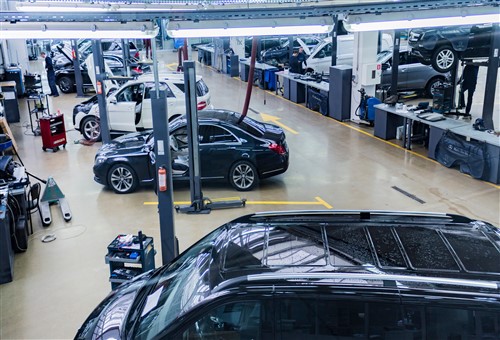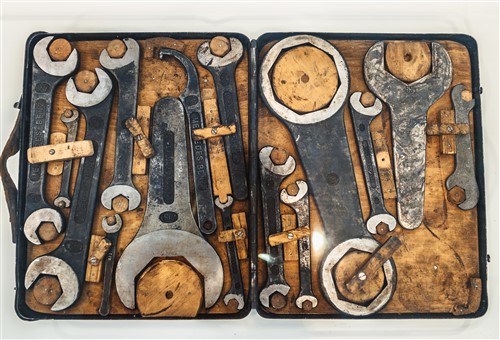
Karl Benz did not only develop the first practical car with an internal combustion engine in 1885/1886. Out of necessity, he also developed the maintenance/service procedures required to keep his invention running. As a matter of fact, some service procedures had to be carried out every few kilometres to keep his “Motorwagen” running semi-reliably even over short distances. These were the really bad days of motoring and although we need not delve into the early history of the motorcar here, we can say that Mercedes now holds a very large number of patents for technical innovations that collectively make Mercedes vehicles what they are today.
However, while technical sophistication in terms of design and construction characterizes modern Mercedes vehicles today, this high level of sophistication is underpinned by an equally high level of complexity that can make our lives as mechanics and technicians very difficult at times. As a practical matter, servicing a modern Mercedes is something that should not be undertaken lightly unless you are a Mercedes expert, but if you are armed with a fair bit of knowledge of what to expect, servicing Mercedes vehicles right the first time becomes a whole lot easier.
Thus, in Part 1 of this two-part article, we will discuss the importance of obtaining OEM service information to avoid at least some of the pitfalls that come with servicing modern Mercedes vehicles. Before we get to specifics, though, consider the image below-

This set of Mercedes tools was all one needed to service/repair most Mercedes models dating from around 1910, which puts things in perspective considering the arsenal of tools one needs to work on modern Mercedes vehicles today but this article is not about special tools. This article will, however, stress the crucial importance of OEM service information relating to several service procedures that could go horribly wrong if you service a modern Mercedes vehicle without consulting said service information.
With the above said, let us look at-

Oil change procedures can be particularly tricky on some Mercedes engines, as the following case study will show-
This writer was recently engaged in a pleasant social visit to the workshop of a former colleague who had recently begun to take in high-end vehicles that are still under the manufacturer's warranty or covered by a service plan. We need not discuss the reasons for his refusal to work on these vehicles before, but suffice it to say that he has picked up a significant amount of new business since his recent change in tack.
Anyway, this writer and his former colleague were exchanging war stories when a young technician stormed into the office with a look of bewilderment on his face and asked his employer to come and have a look at the 2019 Mercedes GLA250 he was servicing.
According to the young technician, he had just filled the engine* with the correct amount of oil, but now the oil was pouring from the air intake. He also claimed not to have overfilled the engine, and that he had replaced the copper sealing washer, and tightened the oil plug correctly.
*This particular Mercedes was fitted with the type 270.920 engine, which is a 2L turbocharged inline 4-cylinder that is also used in various A-Class, B-Class, and CLA-Class models.
So, always ready to discover new automotive mysteries, this writer agreed to provide a second opinion on the issue as he accompanied the former colleague and his young employee to the afflicted Mercedes, and sure enough, there was oil dripping from the air intake. There was also a large pool of fresh oil under the vehicle. Upon opening the air filter box, we found a significant amount of oil under the new but now oil-soaked air filter element.
So what do think happened here? How is it possible for oil to flow into the air filter box, given that the air-operated, drum-mounted oil pump's flow meter showed that the young technician had indeed pumped the correct amount of oil (5.6 litres) into the engine. The former colleague was stumped, and this writer would have been too, but as it happens, this writer had previously seen exactly this issue occur on other type 270.920 engines. Here is what happened, based on OEM service information this writer had found when something similar happened with one of his own customers who elected to change the oil on his own GLA250 on a DIY basis a year or so previously. Due to copyright issues, we cannot quote Mercedes' Engine Oil and Oil Filter procedure for this vehicle verbatim here, but here is a paraphrased version-
"The new engine oil must be poured in at a trickle after removing the dipstick. Pouring in the new oil too quickly will cause a significant backpressure to develop at some points in the positive crankcase ventilation system, which will force the new oil through vent passages to flow into the intake ducting and then pool in the air filter box, as well as in the turbocharger.
Depending on the rate of flow [the] collected oil in the air filter box may flow from the air intake. Be aware also that, attempting to start the engine while liquid oil is present in the air intake system could cause fatal engine damage. (Italics and bolding added for emphasis.)
Fortunately, the young technician noticed the oil spill before he could start the engine. Even so, the costs (and time spent) required to remove the intake system and turbocharger to clean out the pooled oil, as well as the combined costs of the air filter element and the wasted oil, were likely to run to several hundred dollars- not to mention the costs of (potentially) losing a new customer’s business, which brings us to-

Although a disaster had been avoided, the incident led to a rather difficult conversation between the young technician and his employer. We can gloss over most of the details of what was said on both sides, but the gist of it was that the employer called the young technician incompetent (and other things we cannot repeat here) and threatened to fire him on the spot.
In his defence, the young technician stated that he had never worked on this vehicle before, and anyway, who would have thought that just filling an engine with oil could make the oil flow into the intake system? Indeed, who would have thought?
It is not for this writer to express an opinion on who was wrong: the technician for failing to read the relevant service information or his employer for failing to provide the relevant service information. Regardless of who was wrong, though, this case illustrates the point that we do not always know what we don't know, particularly when we are working on unfamiliar vehicles.
Therefore, it is imperative that we, as mechanics and technicians, protect ourselves against liability and accusations of incompetence by always obtaining relevant service information but more importantly, understanding what the service information is telling us. The potential consequences of making assumptions, or worse, failing to obtain and understand OEM service information when we work on unfamiliar vehicles is as, they say, too ghastly to contemplate, which leaves us with-
In Part 2 of this article, we will discuss spark plug and filter replacements on modern Mercedes vehicles, both of which have potentially expensive pitfalls you may not have been aware of, but would want to avoid falling into at all costs.